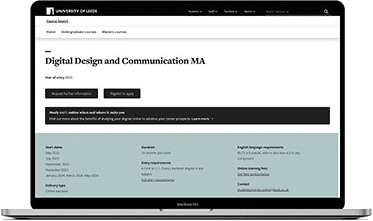5 Digital Design Trends to Look Out for in 2023 and Beyond
Digital Design and Communication
2023 is shaping up to be an exciting year in digital design.
While the design world is unlikely to experience new ground-breaking technologies this year, major advancements in existing ones are on the horizon, enhancing data driven design, AR/VR design, sustainable design and more.
In this blog, we explore the top digital design trends in more detail for you to keep an eye on in the year ahead.
Learn more about our Digital Design and Communication Masters1. The Metaverse
The Metaverse is a vision of what the internet will look like in the future: a virtual world where people shop, go to work, and interact. Imagine experiencing everything in your everyday life through an immersive device. According to Forbes, the Metaverse is anticipated to add $5 trillion in value to the global economy by 2030, with high-profile businesses such as Nike and Gucci already building a presence in the unique online space.
For digital designers responsible for the interactive 3D design of the Metaverse, the level of demand for AR (augmented reality) and VR (virtual reality) design increases as the industry grows. Similarly, as new developments evolve, including the need to pair digital design with touch and smell, and enhance gaming with increasingly immersive visuals, digital designers need to react to these trends and optimise the virtual environments available in the Metaverse.
2. Accessibility requirements
On the 28th of June 2025, the European Accessibility Act (EAA) will come into force, making the accessibility of products and services (both physical and digital) a legal requirement. This is designed to serve those with a disability by improving the inclusivity of materials such as digital television services, audio-visual media services, e-commerce and more.
As a result, businesses are working towards the June 2025 deadline to improve the accessibility of their products. Digital designers are therefore being tasked to make the usability and content of digital platforms and services more user-friendly to those with accessibility needs. From ensuring video content has closed captions to creating webpages with adaptive layouts and readable font sizes, accessibility will rightly be at the forefront of digital designers’ minds for years to come.
3. Dark Mode
While digital designers are busy ensuring colour contrasts meet accessibility criteria, the increasing popularity of ‘Dark Mode’ is posing a continuing challenge for the year ahead.
‘Dark Mode’ is a user interface (UI) design theme offered on electronic devices which reduces the screen brightness for an overall darker look. This digital design trend is set to continue developing in the year ahead, with people opting for it as it’s proven to reduce the strain on their eyes and increase their devices’ battery life.
For digital designers, the use of Dark Mode will alter the colour schemes for their creations. They will need to explore dark backgrounds to be paired with vibrant tones to make colours stand out and help clarify text. It will also place more emphasis on the use of image-focused design materials to avoid what could be an otherwise minimalistic and dull appearance.
4. Digital carbon footprint
“Our materials are fully digital, so they’re better for the planet as nothing’s going to landfill.”
This common misconception is at odds with an emerging agenda for digital designers: to reduce their digital carbon footprint. This refers to the emissions caused by digital production, use and data transfer.
While it’s correct that digital materials reduce paper waste compared to its physical equivalent, digital activity accounted for almost 4% of global greenhouse gas emissions in 2019, predominately down to the electrical consumption of servers and networks.
For designers, some of the biggest emitters in their industry are large image files and high-definition videos which require more memory to store and share. To combat this, the industry is offering solutions such as prioritising text design over video-heavy case studies and using striking typography in place of high-resolution images. However, digital designers will need to convince organisations that these are as good, if not better initiatives both from a sustainability and business performance standpoint.
As knowledge around digital carbon footprint and the need for ‘green initiatives’ develops, those in the design world will be key to sourcing new methods of sustainable design in 2023 and long into the future.
5. 90s vintage revival
To complete our list of the hottest digital design trends in 2023, we’ll need to rewind to the 1990s, where pop culture was working its way into nearly all of the era’s designs.
That’s because the resurgence of vintage trends and 90s nostalgia is experiencing an early 2020s revival, evidenced by Google’s cartoon style advertising and text-based elements of Pepsi’s World Cup commercial.
And as culture heads into a throwback phase, so too will advertising and design materials for some businesses, particularly in industries like fashion and media. This means some digital designers will revisit bright colours, pixelated typography, and visuals representing old VHS cassettes, Game Boys, and other nostalgic items.
Explore further digital design trends with an online Masters
If you’re keen on exploring more digital design trends, you can study the Digital Design Trends module as part of our online Masters course.
You’ll study some of the themes covered in this blog in more depth while discovering new and developing concepts and technologies, and improving your research skills by understanding the theory, practice and needs for the successful application of new digital design trends.
Study Digital Design and Communication online with the University of Leeds
The Digital Design and Communication Masters, delivered fully online by the University of Leeds, is designed for those with the ambition to work in the digital design sector and other creative industries. Taught by experts in the University of Leeds School of Design, it’s influenced by some of the latest trends impacting the industry and is ideal if you see yourself in a managerial role in the digital design field, driving innovation and solving complex communication problems.
Demonstrate Your Expertise as a Digital Design Professional with an innovative online Masters in Digital Design and Communication.

Did you enjoy this blog? Here’s some related digital design and communication content you may be interested in:

Want to learn more about our online Digital Design and Communication course?
Check out the course content and how to apply.

